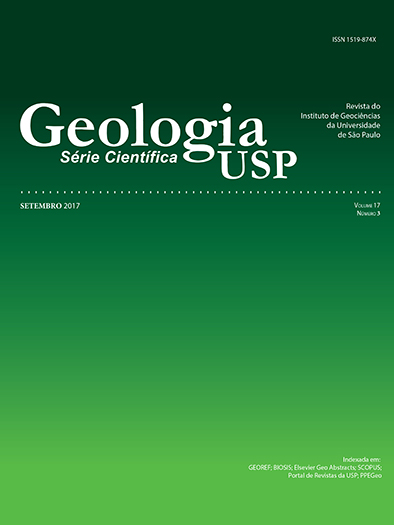Characterization of brittle deformation on a Resende Formation outcrop, Volta Redonda Basin, Rio de Janeiro State
DOI:
https://doi.org/10.11606/issn.2316-9095.v17-391Keywords:
Resende Formation, Poorly Lithified Sandstones, Brittle Deformation, Fault Sealing.Abstract
This work presents the structural characterization and paleostresses analysis on an outcrop of the Resende Formation (Eocene), at the Volta Redonda Basin, Rio de Janeiro, in order to support major discussions regarding the hydraulic behavior of faults on unconsolidated sandstones. The Resende Formation consists of predominantly feldspathic poorly lithified and stratified sandstones, interlayered with greenish mudstones, presenting significant tectonic deformation related to the context of the Continental Rift of Southeastern Brasil. This lithostratigraphic unit represents an analog to similar rock hydrocarbon reservoirs on offshore basins in Southeastern Brazil. The outcrop is located close to the southern border of the Casa de Pedra Graben, the main depocenter at Volta Redonda Basin. Its structural-stratigraphic architecture was build based on a geological section (scale 1: 100), three sedimentological profiles (scale 1:20) and paleostresses analysis of fault/striae pairs. The two major normal faults — F1 and F2 — oriented ENE-WSW, with opposite dipping, split the outcrop in three main blocks, in a graben and horsts patern. Despite the dominant extensional tectonic regime, structural and stratigraphic elements (i.e. Riedel fractures; normal striaes overlapping directional striaes; abrupt variations on the layers thickness) indicate the reactivation upon the F1 and F2 plains due to three consecutive tectonic events related to the RCSB deformation: E-W left-lateral strike slip, E-W right-lateral strike slip and NW-SE extension. The superposition of these tectonic events formed structural elements (i.e. clay smear; juxtaposition; damage zones and core holes; deformation/compaction bands) commonly recognized as key factors affecting the hydraulic behavior of faults, as indicated by the variations observed in the iron oxides cementation pattern between the hanging walls and the footwalls of the major faults.
Downloads
Downloads
Published
Issue
Section
License
Authors who publish in this journal shall comply with the following terms:
- Authors keep their copyright and grant to Geologia USP: Série Científica the right of first publication, with the paper under the Creative Commons BY-NC-SA license (summary of the license: https://creativecommons.org/licenses/by-nc-sa/4.0 | full text of the license: https://creativecommons.org/licenses/by-nc-sa/4.0/legalcode) that allows the non-commercial sharing of the paper and granting the proper copyrights of the first publication in this journal.
- Authors are authorized to take additional contracts separately, for non-exclusive distribution of the version of the paper published in this journal (publish in institutional repository or as a book chapter), granting the proper copyrights of first publication in this journal.
- Authors are allowed and encouraged to publish and distribute their paper online (in institutional repositories or their personal page) at any point before or during the editorial process, since this can generate productive changes as well as increase the impact and citation of the published paper (See The effect of Open Access and downloads on citation impact).





